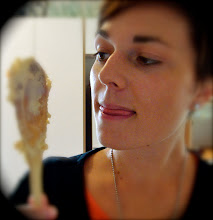 OK- it looks a bit gross.
OK- it looks a bit gross.I'll even go so far as to say that it appears a bit rude... it's not my fault that it looks so anatomical in it's bowl of water.
It's veal tongue by the way.
This is another attempt at a Dutch recipe from the brilliant (and very 'of it's time') 1970's 'Dutch & Belgian Cooking' from Bay Books Round the world cooking library.
God bless the developments in cooking... and god bless Patience for having the courage to try all the dishes that I place in his path. I'm pretty sure that he didn't sign up for this.
I have to say that I went into this dish a sceptic. It could have been hideous for so many reasons. But thankfully this one was a winner, despite it's ubiquitous 'grey' Dutch sauce.
And it's surprisingly simple- as long as you allow for the extended cooking time to melt the tongue into its gelatinous, gooey glory.
This dish was inspiring to me for two reasons.
First, it's Dutch, from one of the few Dutch cookbooks that I've been able to find written in English. I think I've made it pretty clear that I'm on a mission to connect with my Dutch roots, so here I start with looking at Dutch cooking as the first link back to my heritage.
The second reason the dish caught my eye was because I am fascinated by offal, 'olde foode' and the cuts of meat that industrialisation has seen fall by the wayside.
Tongue is one of these. A cut that we often overlook now that mass production allows us to buy prime cuts, prepackaged and divorced from the use of the whole beast.
If I'm going to allow myself to eat and enjoy meat, I'm not going to ignore the more time consuming cuts.
So I'm adding tongue to my diet- and it's a fantastically tasty, unusual and incredibly cheap option.
Veal tongue with sour sauce- Kalfstong met zure saus
Ingredients:

1 veal tongue (about 1kg)
1 tsp salt
1 carrot- peeled and sliced
1 onion- roughly chopped
leafy tops of 1 bunch celery
1 sprig parsley & 1 bay leaf
1/4 tsp grated nutmeg
4 peppercorns- crushed
1 clove
For the sauce:
- 4 tablespoon butter
- 4 tablespoon plain flour
- 2 cups of the cooking liquid (see method)
- 2 eggs (lightly beaten)
- 3 tablespoon white wine vinegar
Method:
Soak the tongue in cold water for several hours or overnight. Rinse the tongue under cold running water and rub lightly with salt.
Place the tongue in a large pot along with the vegetables, herbs and spices and cover with water. Bring to the boil and then reduce to a gentle simmer (advice from Stephanie Alexander's notes on tongue cooking says that the water should be barely moving- otherwise the tongue will toughen).
Simmer gently for 3 hours or until the tongue is tender when a thing skewer is inserted.

At this point you'll need to skin the tongue, so remove it from the pan and while it is still hot peel the outer skin off- it will come off easily while the tongue is still very hot and gets more difficult as the tongue cools, so the quicker the better. The skin is grayish and tough looking and should separate quite easily from the gorgeous glutenous pink meat underneath.
Strain the cooking broth and set aside two cups to make the sauce. Put the rest of the broth, along with the tongue back into the pan to keep warm.
In a new pan melt half of the butter, stir in the flour (taking care to get rid of any lumps that form), then slowly add the cooking broth that you set aside earlier. It's important to do this slowly and the whisk the sauce continuously until you have a smooth sauce.
In a bowl combine a little of this warm sauce with the lightly beaten eggs, whisking to make sure the eggs don't cook in the warm liquid. Then add the egg mixture to the pan of sauce over a low heat and continue to whisk. Add the remaining butter and vinegar.
Do not allow the sauce to boil once the eggs are in otherwise you will get strings of egg protein in the sauce.

Slice the tongue and remove any gristle from the root. Arrange the slices on a warm serving dish and pour a little of the sauce over.
Serve warm with a side of broad beans.
Note: This dish can also be served cold, but is best enjoyed warm when the tongue is still soft.
The buttery sauce is cut beautifully by the sharp vinegar that gives it the 'sour sauce' name and it keeps well in the fridge for a couple of days.
Having not been a huge fan (or so I thought) of tongue before I started cooking this dish, I am now a changed woman and find nothing tastier than freshly cooked veal tongue.
The dish can be made with beef tongue too, but obviously the younger veal cut will provide a more tender result. I'll also be honest and say that the smell of veal tongue is not as pungent as fully fledged beef (for those with sensitive noses). Not that it's a bad smell, it's just very brothy.
They both taste wonderful however and a beef tongue certainly feeds more people.
Eet Smakelijk!
And what an adventure!



No comments:
Post a Comment